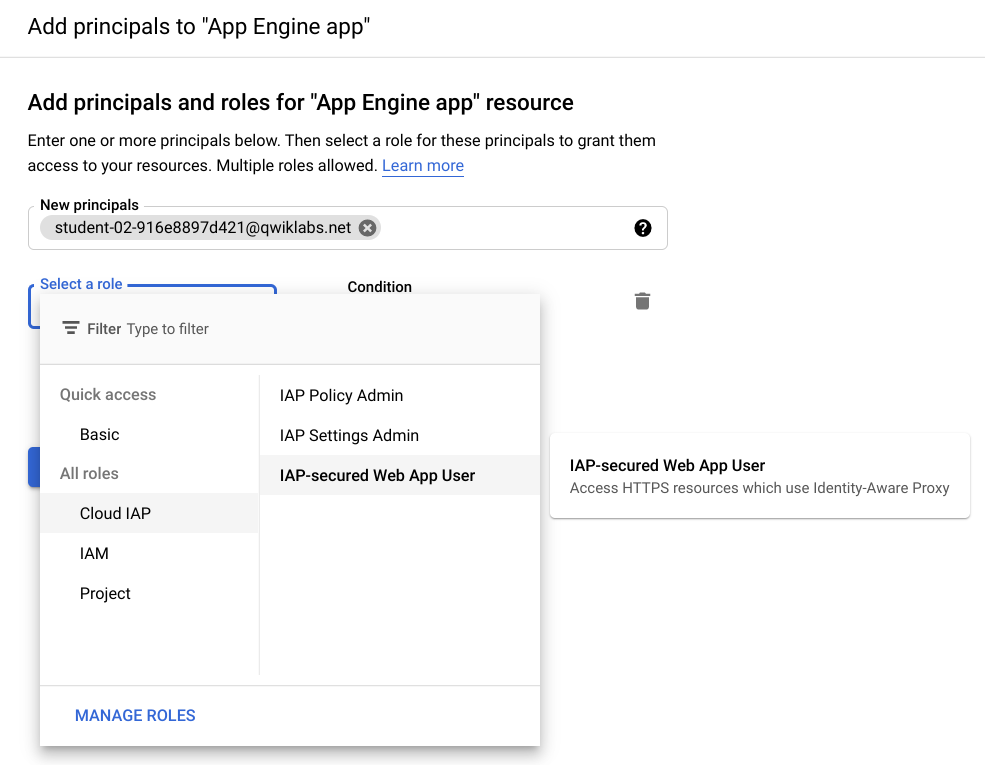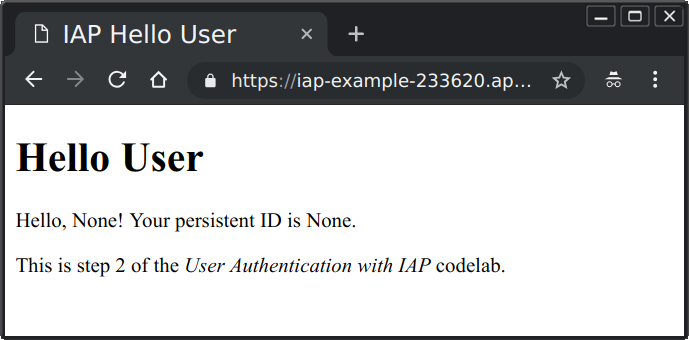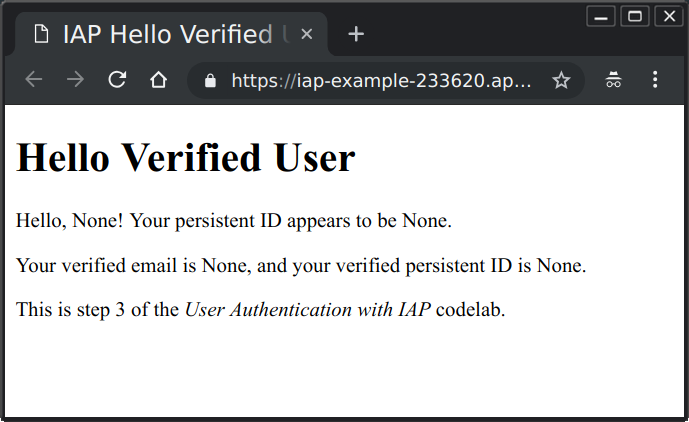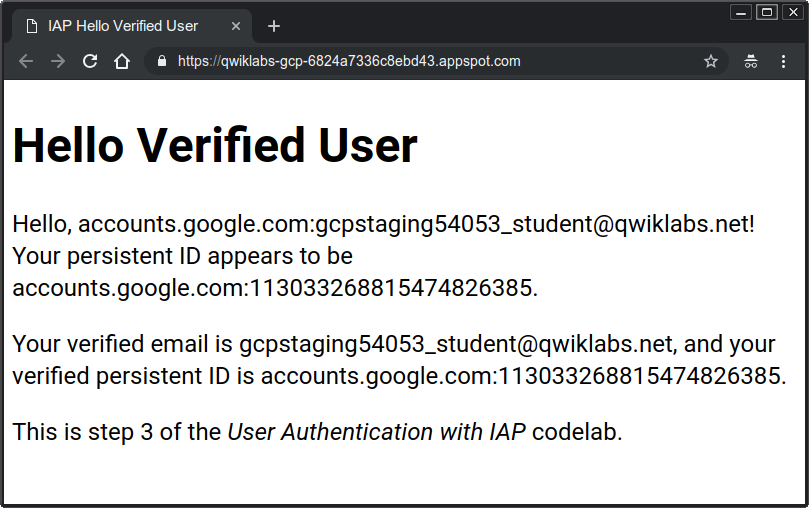Checkpoints
Deploy an App Engine application
/ 20
Enable and add policy to IAP
/ 30
Access User Identity Information
/ 25
Use Cryptographic Verification
/ 25
User Authentication: Identity-Aware Proxy
GSP499
Overview
In this lab, you build a minimal web application with Google App Engine, then explore various ways to use Identity-Aware Proxy (IAP) to restrict access to the application and provide user identity information to it. Your app will:
- Display a welcome page
- Access user identity information provided by IAP
- Use cryptographic verification to prevent spoofing of user identity information
What you'll learn
- How to write and deploy a simple App Engine app using Python
- How to enable and disable IAP to restrict access to your app
- How to get user identity information from IAP into your app
- How to cryptographically verify information from IAP to protect against spoofing
Prerequisites
A basic knowledge of the Python programming language will enhance your learning experience.
This lab is focused on Google App Engine and IAP. Non-relevant concepts and code blocks are glossed over and are provided for you to simply copy and paste.
Introduction to Identity-Aware Proxy
Authenticating users of your web app is often necessary, and usually requires special programming in your app. For Google Cloud apps you can hand those responsibilities off to the Identity-Aware Proxy service. If you only need to restrict access to selected users there are no changes necessary to the application. Should the application need to know the user's identity (such as for keeping user preferences server-side) Identity-Aware Proxy can provide that with minimal application code.
What is Identity-Aware Proxy?
Identity-Aware Proxy (IAP) is a Google Cloud service that intercepts web requests sent to your application, authenticates the user making the request using the Google Identity Service, and only lets the requests through if they come from a user you authorize. In addition, it can modify the request headers to include information about the authenticated user.
Setup and requirements
Before you click the Start Lab button
Read these instructions. Labs are timed and you cannot pause them. The timer, which starts when you click Start Lab, shows how long Google Cloud resources will be made available to you.
This hands-on lab lets you do the lab activities yourself in a real cloud environment, not in a simulation or demo environment. It does so by giving you new, temporary credentials that you use to sign in and access Google Cloud for the duration of the lab.
To complete this lab, you need:
- Access to a standard internet browser (Chrome browser recommended).
- Time to complete the lab---remember, once you start, you cannot pause a lab.
How to start your lab and sign in to the Google Cloud console
-
Click the Start Lab button. If you need to pay for the lab, a pop-up opens for you to select your payment method. On the left is the Lab Details panel with the following:
- The Open Google Cloud console button
- Time remaining
- The temporary credentials that you must use for this lab
- Other information, if needed, to step through this lab
-
Click Open Google Cloud console (or right-click and select Open Link in Incognito Window if you are running the Chrome browser).
The lab spins up resources, and then opens another tab that shows the Sign in page.
Tip: Arrange the tabs in separate windows, side-by-side.
Note: If you see the Choose an account dialog, click Use Another Account. -
If necessary, copy the Username below and paste it into the Sign in dialog.
{{{user_0.username | "Username"}}} You can also find the Username in the Lab Details panel.
-
Click Next.
-
Copy the Password below and paste it into the Welcome dialog.
{{{user_0.password | "Password"}}} You can also find the Password in the Lab Details panel.
-
Click Next.
Important: You must use the credentials the lab provides you. Do not use your Google Cloud account credentials. Note: Using your own Google Cloud account for this lab may incur extra charges. -
Click through the subsequent pages:
- Accept the terms and conditions.
- Do not add recovery options or two-factor authentication (because this is a temporary account).
- Do not sign up for free trials.
After a few moments, the Google Cloud console opens in this tab.

Activate Cloud Shell
Cloud Shell is a virtual machine that is loaded with development tools. It offers a persistent 5GB home directory and runs on the Google Cloud. Cloud Shell provides command-line access to your Google Cloud resources.
- Click Activate Cloud Shell
at the top of the Google Cloud console.
When you are connected, you are already authenticated, and the project is set to your Project_ID,
gcloud is the command-line tool for Google Cloud. It comes pre-installed on Cloud Shell and supports tab-completion.
- (Optional) You can list the active account name with this command:
- Click Authorize.
Output:
- (Optional) You can list the project ID with this command:
Output:
gcloud, in Google Cloud, refer to the gcloud CLI overview guide.
Download the code
Click the command line area in the Cloud Shell so you can type commands.
Download the code from a public storage bucket and then change to the code folder:
This folder contains one subfolder for each step of this lab. You will change to the correct folder to perform each step.
Task 1. Deploy the application and protect it with IAP
This is an App Engine Standard application written in Python that simply displays a "Hello, World" welcome page. We will deploy and test it, then restrict access to it using IAP.
Review the application code
- Change from the main project folder to the
1-HelloWorldsubfolder that contains code for this step.
The application code is in the main.py file. It uses the Flask web framework to respond to web requests with the contents of a template. That template file is in templates/index.html, and for this step contains only plain HTML. A second template file contains a skeletal example privacy policy in templates/privacy.html.
There are two other files: requirements.txt lists all the non-default Python libraries the application uses, and app.yaml tells Google Cloud that this is a Python App Engine application.
You can list each file in the shell using the cat command, as in:
Or you can launch the Cloud Shell code editor by clicking the Pencil icon at the top right-hand side of the Cloud Shell window, and examine the code that way.
You do not need to change any files for this step.
Deploy to App Engine
- Update python runtime to
python39.
- Deploy the app to the App Engine Standard environment for Python.
-
Select a region
. -
When you are asked if you want to continue, enter Y for yes.
gcloud app deploy command.
In a few minutes the deployment completes. You will see a message that you can view your application with gcloud app browse.
- Enter that command:
- Click the displayed link to open it in a new tab, or copy it to a manually opened new tab if necessary. Since this is the first time this app is run, it will take a few seconds to appear while a cloud instance is started, and you should see the following window.
You can open that same URL from any computer connected to the Internet to see that web page. Access is not yet restricted.
Click Check my progress to verify the objective.
Restrict access with IAP
-
In the cloud console window, click the Navigation menu
> Security > Identity-Aware Proxy.
-
Click ENABLE API.
-
Click GO TO IDENTITY-AWARE PROXY.
-
Click CONFIGURE CONSENT SCREEN.
-
Select Internal under User Type and click Create.
-
Fill in the required blanks with appropriate values:
|
Field |
Value |
|
App name |
IAP Example |
|
User support email |
Select your lab student email address from the dropdown. |
|
Application home page |
The URL you used to view your app. You can find this again by running the gcloud app browse command in cloud shell again. |
|
Application privacy Policy link |
The privacy page link in the app, same as the homepage link with |
|
Authorized domains |
Click + ADD DOMAINThe hostname portion of the application's URL, e.g. iap-example-999999.appspot.com. You can see this in the address bar of the Hello World web page you previously opened. Do not include the starting |
|
Developer Contact Information |
Enter at least one email |
-
Click Save and Continue.
-
For Scopes, click Save and Continue.
-
For Summary, click Back to Dashboard.
You might be prompted to create credentials. You do not need to create credentials for this lab, so you can simply close this browser tab.
- In Cloud Shell, run this command to disable the Flex API:
- Return to the Identity-Aware Proxy page and refresh it. You should now see a list of resources you can protect.
Click the toggle button in the IAP column in the App Engine app row to turn IAP on.
- The domain will be protected by IAP. Click Turn On.
Test that IAP is turned on
-
Open a browser tab and navigate to the URL for your app. A Sign in with Google screen opens and requires you to log in to access the app.
-
Sign in with the account you used to log into the console. You will see a screen denying you access.
You have successfully protected your app with IAP, but you have not yet told IAP which accounts to allow through.
- Return to the Identity-Aware Proxy page of the console, select the checkbox next to App Engine app, and see the App Engine sidebar to the right.
Each email address (or Google Group address, or Workspace domain name) that should be allowed access needs to be added as a Member.
-
Click Add Principal.
-
Enter your Student email address.
-
Then, pick the Cloud IAP > IAP-Secured Web App User role to assign to that address.
You may enter more addresses or Workspace domains in the same way.
- Click Save.
The message "Policy Updated" will appear at the bottom of the window.
Click Check my progress to verify the objective.
Test access
Navigate back to your app and reload the page. You should now see your web app, since you already logged in with a user you authorized.
If you still see the "You don't have access" page, IAP did not recheck your authorization. In that case, do the following steps:
- Open your web browser to the home page address with
/_gcp_iap/clear_login_cookieadded to the end of the URL, as inhttps://iap-example-999999.appspot.com/_gcp_iap/clear_login_cookie. - You will see a new Sign in with Google screen, with your account already showing. Do not click the account. Instead, click Use another account, and re-enter your credentials.
These steps cause IAP to recheck your access and you should now see your application's home screen.
If you have access to another browser or can use Incognito Mode in your browser, and have another valid Gmail or Workspace account, you can use that browser to navigate to your app page and log in with the other account. Since that account has not been authorized, it will see the "You Don't Have Access" screen instead of your app.
Task 2. Access user identity information
Once an app is protected with IAP, it can use the identity information that IAP provides in the web request headers it passes through. In this step, the application will get the logged-in user's email address and a persistent unique user ID assigned by the Google Identity Service to that user. That data will be displayed to the user in the welcome page.
- In Cloud Shell, change to the folder for this step:
Deploy to App Engine
- Update python runtime to
python39.
- Since deployment takes a few minutes, start by deploying the app to the App Engine Standard environment for Python:
- When you are asked if you want to continue, enter Y for yes.
In a few minutes the deployment should complete. While you are waiting you can examine the application files as described below.
Click Check my progress to verify the objective.
Examine the application files
This folder contains the same set of files as seen in the previous app you deployed, 1-HelloWorld, but two of the files have been changed: main.py and templates/index.html. The program has been changed to retrieve the user information that IAP provides in request headers, and the template now displays that data.
There are two lines in main.py that get the IAP-provided identity data:
The X-Goog-Authenticated-User- headers are provided by IAP, and the names are case-insensitive, so they could be given in all lower or all upper case if preferred. The render_template statement now includes those values so they can be displayed:
The index.html template can display those values by enclosing the names in double curly braces:
As you can see, the provided data is prefixed with accounts.google.com, showing where the information came from. Your application can remove everything up to and including the colon to get the raw values if desired.
Test the updated IAP
Going back to the deployment, when it is ready, you will see a message that you can view your application with gcloud app browse.
- Enter that command:
- If a new tab does not open on your browser, copy the displayed link and open it in a new tab normally. You should see a page similar to the following:
You may need to wait a few minutes for the new version of your application to replace the prior version. Refresh the page if needed to see a page similar to the above.
Turn off IAP
What happens to this app if IAP is disabled, or somehow bypassed (such as by other applications running in your same cloud project)? Turn off IAP to see.
- In the cloud console window, click Navigation menu > Security > Identity-Aware Proxy.
- Click the IAP toggle switch next to App Engine app to turn IAP off. Click TURN OFF.
You will be warned that this will allow all users to access the app.
- Refresh the application web page. You should see the same page, but without any user information:
Since the application is now unprotected, a user could send a web request that appeared to have passed through IAP. For example, you can run the following curl command from the Cloud Shell to do that (replace <your-url-here> with the correct URL for your app):
The web page will be displayed on the command line, and look like the following:
There is no way for the application to know that IAP has been disabled or bypassed. For cases where that is a potential risk, Cryptographic Verification shows a solution.
Task 3. Use Cryptographic Verification
If there is a risk of IAP being turned off or bypassed, your app can check to make sure the identity information it receives is valid. This uses a third web request header added by IAP, called X-Goog-IAP-JWT-Assertion. The value of the header is a cryptographically signed object that also contains the user identity data. Your application can verify the digital signature and use the data provided in this object to be certain that it was provided by IAP without alteration.
Digital signature verification requires several extra steps, such as retrieving the latest set of Google public keys. You can decide whether your application needs these extra steps based on the risk that someone might be able to turn off or bypass IAP, and the sensitivity of the application.
- In Cloud Shell, change to the folder for this step:
Deploy to App Engine
- Update python runtime to
python39.
- Deploy the app to the App Engine Standard environment for Python:
- When you are asked if you want to continue, enter Y for yes.
In a few minutes the deployment should complete. While you are waiting you can examine the application files as described below.
Click Check my progress to verify the objective.
Examine the application files
This folder contains the same set of files as seen in 2-HelloUser, with two files altered and one new file. The new file is auth.py, which provides a user() method to retrieve and verify the cryptographically signed identity information. The changed files are main.py and templates/index.html, which now use the results of that method. The unverified headers as found in the last deployment are also shown for comparison.
- The new functionality is primarily in the
user()function:
The assertion is the cryptographically signed data provided in the specified request header. The code uses a library to validate and decode that data. Validation uses the public keys that Google provides for checking data it signs, and knowing the audience that the data was prepared for (essentially, the Google Cloud project that is being protected). Helper functions keys() and audience() gather and return those values.
The signed object has two pieces of data we need: the verified email address, and the unique ID value (provided in the sub, for subscriber, standard field).
This completes Step 3.
Test the Cryptographic Verification
When the deployment is ready you will see a message that you can view your application with gcloud app browse.
- Enter that command:
If a new tab does not open on your browser, copy the displayed link and open it in a new tab normally.
Recall that you previously disabled IAP, so the application provides no IAP data. You should see a page similar to the following:
As before, you may need to wait a few minutes for the newest version to be live to see the new version of the page.
Since IAP is disabled, no user information is available. Now turn IAP back on.
-
In the cloud console window, click the Navigation menu > Security > Identity-Aware Proxy.
-
Click the IAP toggle switch next to App Engine app to turn IAP on again. Click TURN ON.
-
Refresh the page. The page should look like the following:
Notice that the email address provided by the verified method does not have the accounts.google.com: prefix.
If IAP is turned off or bypassed, the verified data would either be missing, or invalid, since it cannot have a valid signature unless it was created by the holder of Google's private keys.
Congratulations!
You deployed an App Engine web application. First, you restricted access to the application to only users you chose. Then you retrieved and displayed the identity of users that IAP allowed access to your application, and saw how that information might be spoofed if IAP were disabled or bypassed. Lastly, you verified cryptographically signed assertions of the user's identity, which cannot be spoofed.
Next steps / Learn more
- Get more detail about Cloud Identity-Aware Proxy.
- Check out other Google Security products.
Google Cloud training and certification
...helps you make the most of Google Cloud technologies. Our classes include technical skills and best practices to help you get up to speed quickly and continue your learning journey. We offer fundamental to advanced level training, with on-demand, live, and virtual options to suit your busy schedule. Certifications help you validate and prove your skill and expertise in Google Cloud technologies.
Manual Last Updated April 15, 2024
Lab Last Tested February 28, 2024
Copyright 2024 Google LLC All rights reserved. Google and the Google logo are trademarks of Google LLC. All other company and product names may be trademarks of the respective companies with which they are associated.






